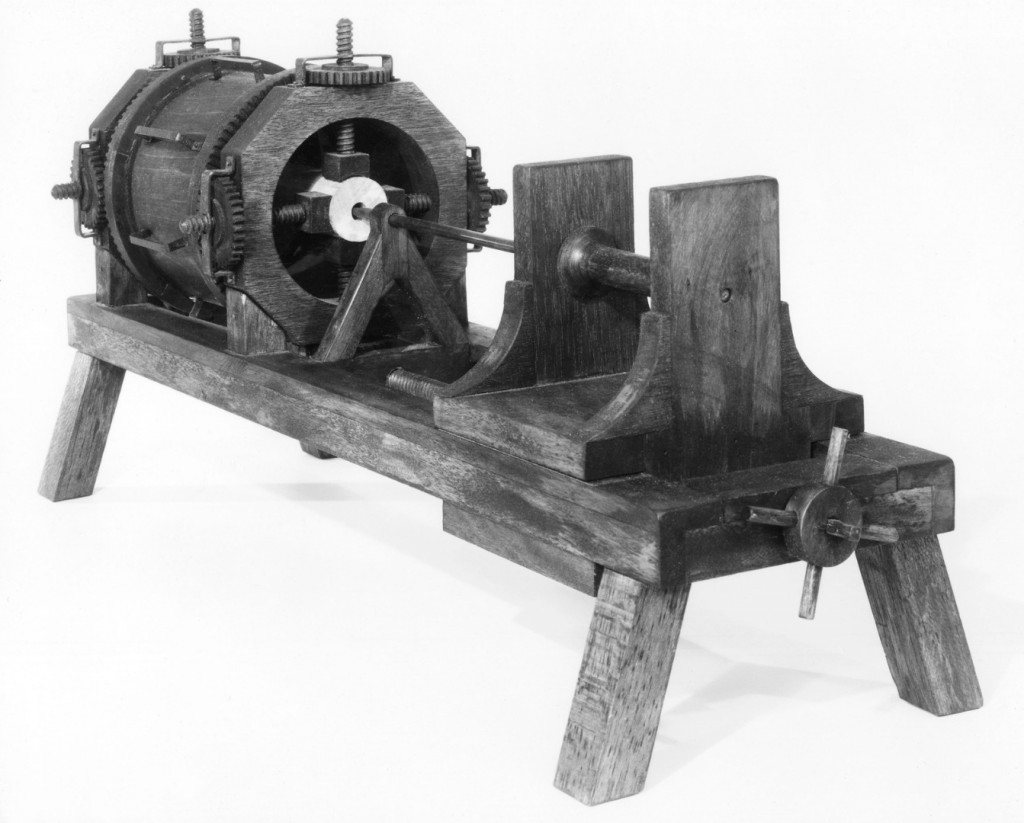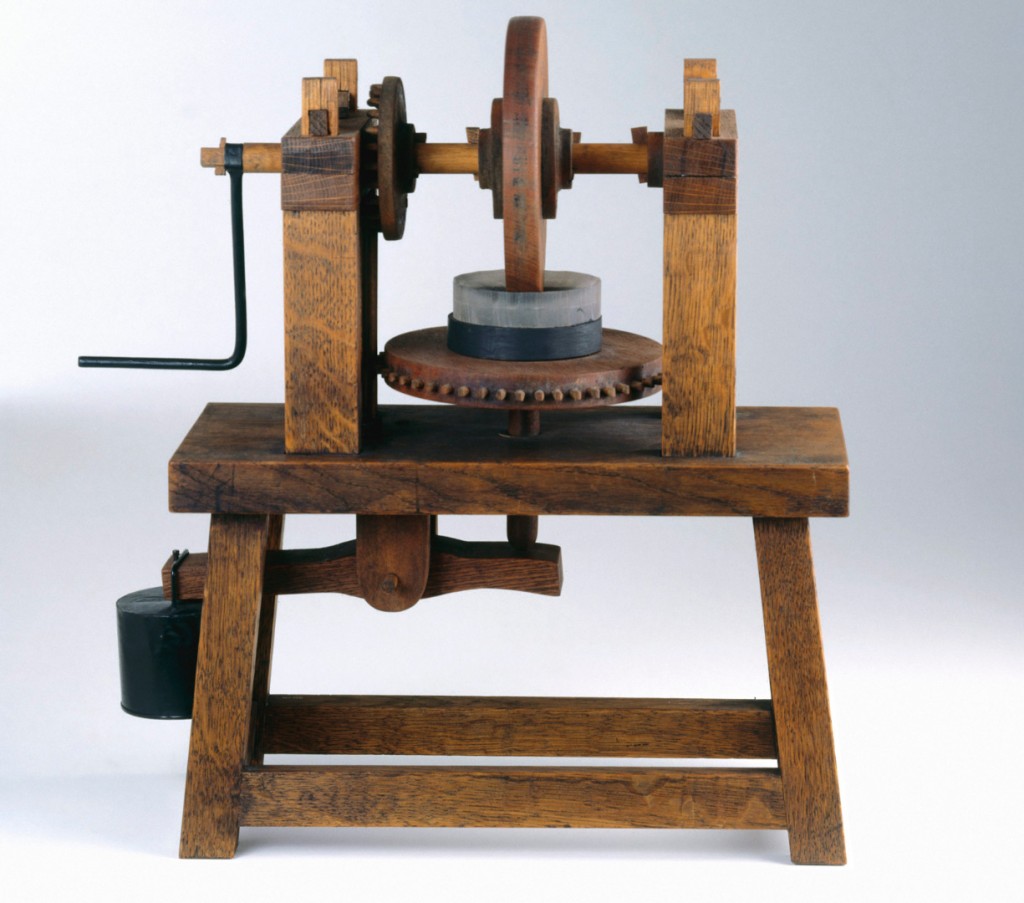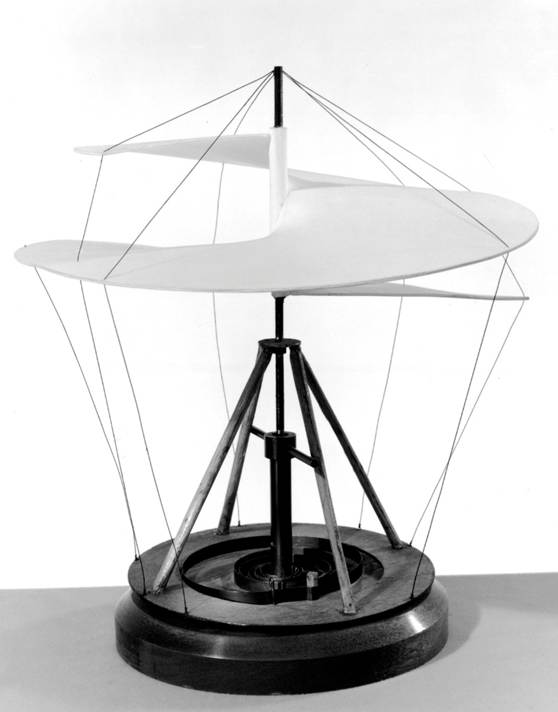For the Leonardo da Vinci: the Mechanics of Genius exhibition which opens here tomorrow (10 February to 4 September 2016), each host Museum has the opportunity to add a section of their own, giving the exhibition some local flavour.
So I searched the collections database to see what we have with a Leonardo connection. I wasn’t expecting oil paintings or crayon sketches but I did find an intriguing set of nine models made in 1952 and based on Leonardo’s drawings.

The models had been commissioned by the Museum from a model engineering workshop in Wimbledon. With help I tracked them down in the store and found an attractive group of carefully-made models, mostly in wood, in a deliberately unassuming style, as though considered appropriate to mechanical experiment. These were not imitations of objects that might be set before a Renaissance prince.
My next stop was the wonderful ‘Registry’ in the Museum, where thousands of files document all the doings of the staff in the era of paper records – schemes, memos, letters, drafts for letters, comments, reactions, all added sequentially to growing bundles in manila folders. Curators would add their comments and pass the file, in the internal mail, to the next recipient, so the record is full and rich. How a story such as the one I found in the relevant file might survive in the era of email is anyone’s guess.
This was the easiest piece of historical research I have ever done: I had only to turn the pages of the file and a great story unfolded.
In 1949 a fairly new and relatively junior curator, Keith Gilbert, working in ‘textile mechanics’, had a bright idea and he opened a file. He passed it to his ‘Keeper’ with a proposal for an exhibition in 1952 to mark the 500th anniversary of Leonardo’s birth, which included making models for display. This was an ambitious notion – a ‘special exhibition’, though common enough now, was not something the Science Museum did in the late 1940s. The other curators added unenthusiastic comments, with a range of excuses – no space was available, the workshop was too busy, and anyway, was Leonardo really a scientist?

Gilbert’s surprising response was to propose a much more ambitious project! Now I really sat up – a good story was emerging from the file. A much larger exhibition would be a collaboration between different institutions and be organised by a ‘representative committee’. The new Director, Frank Sherwood Taylor was tempted and approached the British Museum, who suggested contacting the Royal Academy.
For then on the project steamed ahead. Gilbert and Sherwood Taylor found themselves in a different world – one where ‘culture’ opened many doors, where expectations were high and imaginative proposals were welcome. The anxiety now was whether they could hold their own? Would the Museum’s contribution to the large exhibition live up to the occasion? Would science be swamped by art?
In fact the exhibition was a great success, including the gallery on science. The public flocked in, opening hours were extended and the period of the exhibition more than doubled. The Royal Academy made a sizeable profit and renovated their heating system with the proceeds. Their Director, the portrait painter Sir Gerald Kelly wrote to Sherwood Taylor when it was all over: ‘when next you have another such idea, please don’t hesitate to let us know!’

In fact it had all been Keith Gilbert’s idea, but he too had his moment in the limelight. A prestigious series of lectures was planned to accompany the exhibition and a speaker was sought for one on Leonardo the engineer. In the end it had to be admitted that Gilbert himself was the only person available who seemed to understand the subject and he had to join a lecture list with such cultural luminaries as Kenneth Clark, Ernst Gombrich and Nikolaus Pevsner.
It wasn’t all glamorous. Both Gilbert and Kelly also lectured to 800 industrial apprentices. On the mechanical side, Gilbert again was considered the only person up to the task, while Sir Gerald did his best to rise to the occasion in dealing with Leonardo’s art. The Times reported that he told the apprentices that Leonardo had ‘extraordinary eyesight … he would have made a great cricketer – probably bowling googlies, for he was a most ingenious man’.
You can read the full story in the Science Museum Group Journal here. Three of the models (pictured above) will be shown in London for our new Leonardo exhibition. They are small and modest in appearance, as befitted the limited resources available to the Science Museum in the period following the Second World War. In a slightly tongue-in-cheek allusion to this link to our situation today, the additional display has the title, ‘Leonardo for a Time of Austerity’.
Jim Bennett is Keeper Emeritus at the Science Museum.
Leonardo da Vinci: The Mechanics of Genius opens at the Science Museum on 10 February 2016 and will run until 4 September 2016. Designed and produced by Cité des Sciences in cooperation with the Museo Nazionale della Scienza e della Tecnologia Leonardo da Vinci.
This exhibition was designed and produced by Cité des Sciences, a Universcience site, in cooperation with the Museo Nazionale della Scienza e della Tecnologia Leonardo da Vinci (MUST) and with the support of its industrial partner Airbus Group. The exhibition is supported by players of People’s Postcode Lottery, and this week the Museum has been selected to feature as People’s Postcode Lottery’s Charity of the Week.